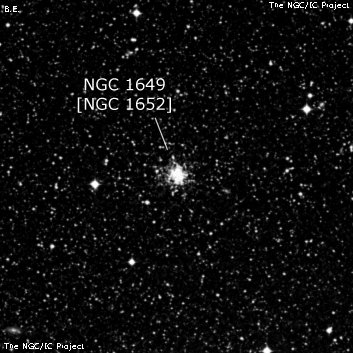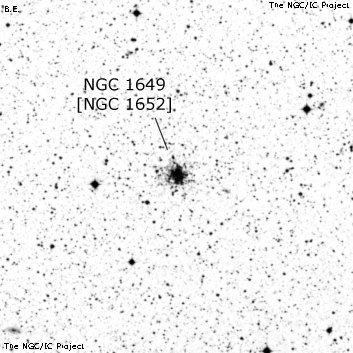NGC/IC Project Restoration Effort
(This is a very very beta version)
NGC1649


Basic Information
Location and Magnitude
Right Ascension: 4:38:22.9
Declination: -68:40:23
Constellation: DOR
Visual Magnitude: 13.1
Historic Information
Discoverer: Herschel J.
Year of discovery: 1834
Discovery aperture: 18.3
Observational
Summary description: F, pS, R, gbM
Sub-type: OCL
Corwin's Notes
=====
NGC 1649 is probably NGC 1652. JH has only one observation of NGC 1649 in
Sweep 523 that puts it about 9 arcmin south and 6 seconds preceding NGC 1652
(his original data for N1649 are 04 38 43.3, -69 08 37 for 1830). This is
only a few arcsec from the star SAO 249073, but JH makes no mention of a
nearby bright star in his observation.
NGC 1652 is an LMC cluster which JH observed on three nights (Sweeps 508, 653,
and 759) with fairly accordant positions (the unweighted mean is 04 38 49.2,
-68 59 56; 1830). JH did not record N1652 in the sweep in which he found
N1649.
Also interesting are his descriptions: they are virtually identical in sweeps
523 and 759. He writes `F, R, gbM, 30",' and `F, R, gbM, 35",' respectively.
The descriptions in sweeps 508 and 653 make the cluster `vF, S, R, gbM, 12" '
and `vF, S, R'.
Since the difference in declination is close to 10 arcmin (a digit error that
JH and others made several times), and the RA's are not very much different --
many other CGH observations also show RA differences of six seconds or more of
time, especially as far south as the LMC -- I think that the two NGC numbers
refer to the same object. Hodge and Wright came to the same conclusion in the
LMC Atlas, but are rather cautious and say, "Possibly NGC 1652. Declination
off by 9'." (Another very similar case is NGC 241 and NGC 242 in the SMC.
See those for the discussion.)
However, just eight arcmin south of NGC 1652 is a faint LMC cluster (ESO
055-SC031 = KMHK 022) that Lauberts, in ESO-B, suggested might be NGC 1649,
though with two question marks and a note commenting on the declination
difference. He also has N1649 = N1652 with one less question mark. KMHK
(Konzitas et al, A&AS 84, 527, 1990) do not use the NGC number on the cluster,
and apparently did not notice the ESO-B entry. Bica et al (AJ 117, 238,
1999), however, use N1649 for the cluster, and also note the ESO entry.
Jenni Kay has also picked up the faint cluster with her 12.5-inch reflector,
so it is not impossible that JH saw it while sweeping. In an email to Jenni
and to Mati Morel (who alerted me to Jenni's observation) I wondered, though,
if the SAO star might hinder JH's ability to see the very faint cluster. It
certainly did not get in Jenni's way! Jenni, by the way, argues that this
cluster is NGC 1649: JH saw two clusters here -- albeit not at the same time
-- so let's give him the benefit of the doubt. See her "Visual Atlas of the
Magellanic Clouds" for her comments.
Mati, in response, listed eight cases where JH found objects near bright stars
(V < 9.5) in the LMC. JH mentions the star (or stars) in only four of his
descriptions, so the presence of the star alone would probably not be an
obstacle to his having seen the cluster, assuming that it (the cluster) is
bright and large enough to have attracted his notice during a sweep.
So, keeping Jenni's and Mati's comments in mind, I do have a bit of doubt
about the identity of NGC 1649 -- but not much. I think the evidence in JH's
observations leads to its identity with NGC 1652.
Steve's Notes
=====
NGC 1649
30" (11/6/10 - Coonabarabran, 264x): fairly faint, small, round, 20" diameter. Sandwiched between 8.1 HD 29994 2.1' SSE and a mag 12 star 1.4' NNW. Located 6.5' SSW of NGC 1652. The identification of NGC 1649 is disputed. It may refer to the small cluster described above or more likely NGC 1649 is a duplicate observation of NGC 1652.



